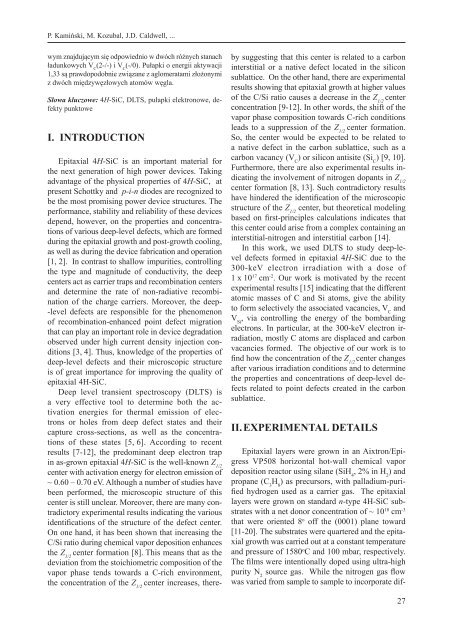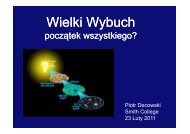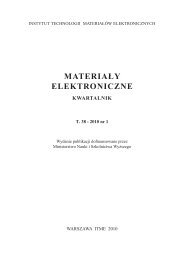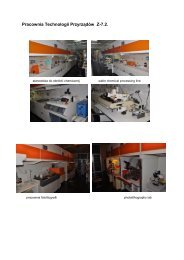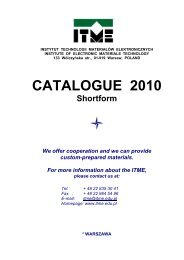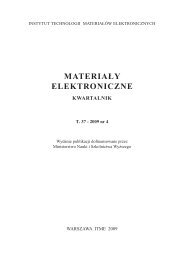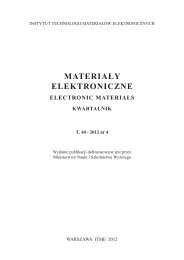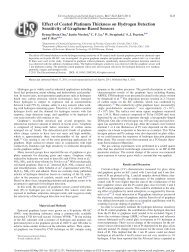MATERIAÅY ELEKTRONICZNE - ITME
MATERIAÅY ELEKTRONICZNE - ITME
MATERIAÅY ELEKTRONICZNE - ITME
Create successful ePaper yourself
Turn your PDF publications into a flip-book with our unique Google optimized e-Paper software.
P. Kamiński, M. Kozubal, J.D. Caldwell, ...<br />
wym znajdującym się odpowiednio w dwóch różnych stanach<br />
ładunkowych V C<br />
(2-/-) i V C<br />
(-/0). Pułapki o energii aktywacji<br />
1,33 są prawdopodobnie związane z aglomeratami złożonymi<br />
z dwóch międzywęzłowych atomów węgla.<br />
Słowa kluczowe: 4H-SiC, DLTS, pułapki elektronowe, defekty<br />
punktowe<br />
I. INTRODUCTION<br />
Epitaxial 4H-SiC is an important material for<br />
the next generation of high power devices. Taking<br />
advantage of the physical properties of 4H-SiC, at<br />
present Schottky and p-i-n diodes are recognized to<br />
be the most promising power device structures. The<br />
performance, stability and reliability of these devices<br />
depend, however, on the properties and concentrations<br />
of various deep-level defects, which are formed<br />
during the epitaxial growth and post-growth cooling,<br />
as well as during the device fabrication and operation<br />
[1, 2]. In contrast to shallow impurities, controlling<br />
the type and magnitude of conductivity, the deep<br />
centers act as carrier traps and recombination centers<br />
and determine the rate of non-radiative recombination<br />
of the charge carriers. Moreover, the deep-<br />
-level defects are responsible for the phenomenon<br />
of recombination-enhanced point defect migration<br />
that can play an important role in device degradation<br />
observed under high current density injection conditions<br />
[3, 4]. Thus, knowledge of the properties of<br />
deep-level defects and their microscopic structure<br />
is of great importance for improving the quality of<br />
epitaxial 4H-SiC.<br />
Deep level transient spectroscopy (DLTS) is<br />
a very effective tool to determine both the activation<br />
energies for thermal emission of electrons<br />
or holes from deep defect states and their<br />
capture cross-sections, as well as the concentrations<br />
of these states [5, 6]. According to recent<br />
results [7-12], the predominant deep electron trap<br />
in as-grown epitaxial 4H-SiC is the well-known Z 1/2<br />
center with activation energy for electron emission of<br />
~ 0.60 – 0.70 eV. Although a number of studies have<br />
been performed, the microscopic structure of this<br />
center is still unclear. Moreover, there are many contradictory<br />
experimental results indicating the various<br />
identifications of the structure of the defect center.<br />
On one hand, it has been shown that increasing the<br />
C/Si ratio during chemical vapor deposition enhances<br />
the Z 1/2<br />
center formation [8]. This means that as the<br />
deviation from the stoichiometric composition of the<br />
vapor phase tends towards a C-rich environment,<br />
the concentration of the Z 1/2<br />
center increases, thereby<br />
suggesting that this center is related to a carbon<br />
interstitial or a native defect located in the silicon<br />
sublattice. On the other hand, there are experimental<br />
results showing that epitaxial growth at higher values<br />
of the C/Si ratio causes a decrease in the Z 1/2<br />
center<br />
concentration [9-12]. In other words, the shift of the<br />
vapor phase composition towards C-rich conditions<br />
leads to a suppression of the Z 1/2<br />
center formation.<br />
So, the center would be expected to be related to<br />
a native defect in the carbon sublattice, such as a<br />
carbon vacancy (V C<br />
) or silicon antisite (Si C<br />
) [9, 10].<br />
Furthermore, there are also experimental results indicating<br />
the involvement of nitrogen dopants in Z 1/2<br />
center formation [8, 13]. Such contradictory results<br />
have hindered the identification of the microscopic<br />
structure of the Z 1/2<br />
center, but theoretical modeling<br />
based on first-principles calculations indicates that<br />
this center could arise from a complex containing an<br />
interstitial-nitrogen and interstitial carbon [14].<br />
In this work, we used DLTS to study deep-level<br />
defects formed in epitaxial 4H-SiC due to the<br />
300-keV electron irradiation with a dose of<br />
1 x 10 17 cm -2 . Our work is motivated by the recent<br />
experimental results [15] indicating that the different<br />
atomic masses of C and Si atoms, give the ability<br />
to form selectively the associated vacancies, V C<br />
and<br />
V Si<br />
, via controlling the energy of the bombarding<br />
electrons. In particular, at the 300-keV electron irradiation,<br />
mostly C atoms are displaced and carbon<br />
vacancies formed. The objective of our work is to<br />
find how the concentration of the Z 1/2<br />
center changes<br />
after various irradiation conditions and to determine<br />
the properties and concentrations of deep-level defects<br />
related to point defects created in the carbon<br />
sublattice.<br />
II. EXPERIMENTAL DETAILS<br />
Epitaxial layers were grown in an Aixtron/Epigress<br />
VP508 horizontal hot-wall chemical vapor<br />
deposition reactor using silane (SiH 4<br />
, 2% in H 2<br />
) and<br />
propane (C 3<br />
H 8<br />
) as precursors, with palladium-purified<br />
hydrogen used as a carrier gas. The epitaxial<br />
layers were grown on standard n-type 4H-SiC substrates<br />
with a net donor concentration of ~ 10 18 cm -3<br />
that were oriented 8 o off the (0001) plane toward<br />
[11-20]. The substrates were quartered and the epitaxial<br />
growth was carried out at a constant temperature<br />
and pressure of 1580 o C and 100 mbar, respectively.<br />
The films were intentionally doped using ultra-high<br />
purity N 2<br />
source gas. While the nitrogen gas flow<br />
was varied from sample to sample to incorporate dif-<br />
27


